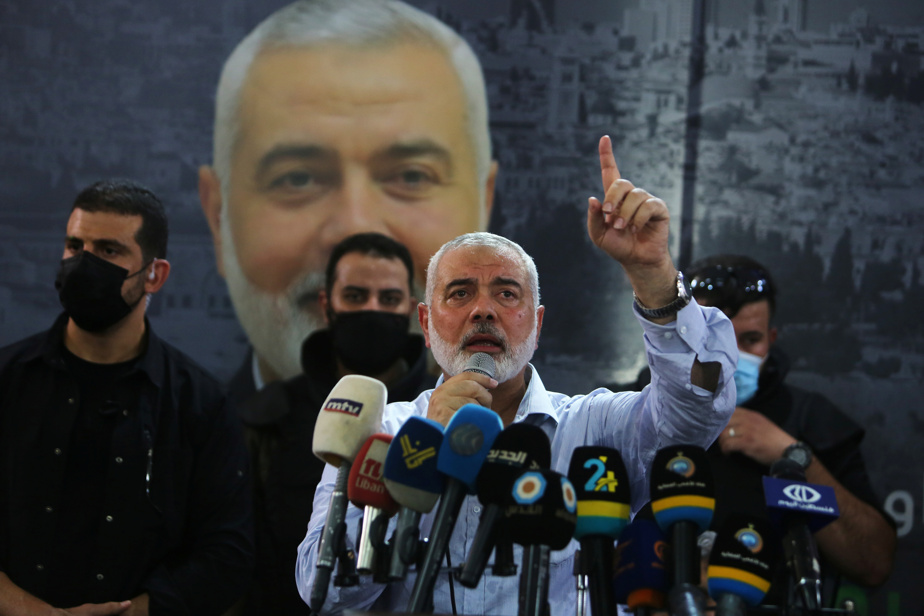(Jerusalem) Accustomed to crossing swords with Israel, Palestinian Hamas took a mortal risk by launching a major bloody offensive against the Hebrew state, determined to eradicate it to avenge its deaths and reestablish its deterrent force, putting harmed by a humiliating snub.
Created in December 1987 at the start of the first Intifada (uprising) against the Israeli occupation by militants claiming to be from the Muslim Brotherhood, Hamas became, from the 1990s, the spearhead of the armed struggle against Israel at the time. where Yasser Arafat’s Palestine Liberation Organization (PLO) turned away in favor of a peace process that never kept its promises.
Hamas has developed a vast network of social services and charities, including schools, accounting for an influence and popularity that has continued to grow at the expense of a Palestinian Authority seen by many as corrupt and complicit in ‘Israel.
The current leader of Hamas (Arabic acronym for Islamic Resistance Movement), Ismaïl Haniyeh, lives between Turkey and Qatar, while the group is led in Gaza by Yahya Sinouar, a figure in its hard wing.
Israel’s public enemy number one who has attempted to assassinate it on several occasions, the elusive Mohammed Deif heads its armed wing, the Al-Qassam brigades.
Furious at having been prevented from exercising real power despite its victory in the 2006 legislative elections, Hamas – considered terrorist by Israel, Washington and the European Union – in 2007 dislodged the Palestinian Authority of President Mahmoud Abbas from the Gaza Strip to become its undisputed master.
After this coup, Israel, which unilaterally withdrew its army and its settlers from the Gaza Strip in 2005, imposed a strict blockade there, described by the UN as “collective punishment”.
Truce
Despite several Israeli offensives intended to stop rocket fire from Gaza, Hamas has remained in power in the cramped territory where 2.3 million Palestinians, mainly descendants of refugees, are pushed to leave their lands in what became the State of Israel when it was created in 1948.
Hamas and Israel agreed in 2018 on a long-term truce aimed at stabilizing the Gaza Strip, undermined by poverty and unemployment, thanks to mediation led by the UN, Egypt and the Qatar.
If Hamas had initiated a new round of hostilities with Israel in 2021, it had refrained from intervening during the last clashes in May 2023 between the Israeli army and Islamic Jihad, also influential in the Gaza Strip.
Hamas’s rivals accuse it of acting for its own interests by respecting a truce with Israel in return in particular for a reduction in the blockade to stem a deterioration of the situation in Gaza which was putting its power under pressure.
But political instability in Israel and the arrival in 2022 of a government led by Benjamin Netanyahu giving pride of place to the extremist right hostile to any concession, has disrupted this arrangement.
The impotence of Hamas in the face of the deterioration of the situation in Gaza is one of the reasons which decided it to launch its offensive of October 7, during which more than 1,200 Israelis were killed according to the army and officials. dozens of others kidnapped, estimates political columnist George Giacaman, professor at Birzeit University in the West Bank.
“Life in Gaza had become unbearable. Water and electricity are lacking and unemployment is very high. Gaza is a big prison that depends on Israel for food and for that the crossing points must be open. The population’s anger against Israel has transformed into anger against the government, and therefore against Hamas,” Mr. Giacaman told AFP.
“Large-scale response”
The timing of the operation, called “Al-Aqsa Flood”, is also linked, according to Mr. Giacaman, “to the escalation of the Israeli extreme right on the Al-Aqsa mosque”, the third holiest site in the world. Islam in the Old City of Jerusalem.
The increase in visits to the site by Jewish faithful, who also consider it sacred, is seen as a “provocation” by the Palestinians.
“It is both a religious and national symbol whose importance to Palestinians should never be taken lightly,” says Mr. Giacaman. This context in Al-Aqsa “was an opportunity for Hamas to launch its attack”.
Massive Israeli reprisals in Gaza have to date left more than 1,300 people dead, the majority of them civilians, according to the authorities, and caused widespread destruction. Mr. Netanyahu warned Wednesday that “any member of Hamas is a dead man,” adding that Israel wants to “crush and destroy” the movement.
Israel has eliminated several Hamas leaders in the past – in March 2004 its spiritual leader Sheikh Ahmad Yassine and his successor Abdel Aziz Rantissi a month later – in response to attacks claimed by the movement, without succeeding in lastingly weakening it.
“It would be unthinkable for Hamas leaders not to expect a large-scale Israeli response, which could further devastate Gaza, inflict heavy losses on its long-suffering population, and perhaps sound the death knell for the domination of Hamas in the enclave,” analyzes the International Crisis Group (ICG).
